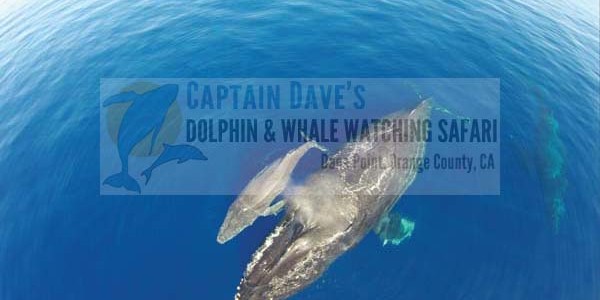(Above: Taken from the actual video footage Captain Dave shot with his quadcopter off the coast of Maui, HI, this image of a mother humpback whale and her calf is simply breathtaking.)
A new perspective of the animal world
When Captain Dave Anderson of Capt. Dave’s Dolphin & Whale Watching Safari in Dana Point, CA, took notice of new quadcopter technology being used on TV, he went all in! He used a quadcopter to capture some absolutely amazing video footage that literally transforms the way we’re able to see the natural world. His newest aerial video includes a huge mega-pod formed by thousands of common dolphins “stampeding” off the coast of Dana Point, three gray whales migrating down the coast off San Clemente, CA, and even close-ups of a newborn humpback whale calf playing and snuggling with its mom, which he recently filmed in Maui, HI.
Launched from the whale watch boat the Manute’a, Capt. Dave uses an inflatable two-man Zodiac to launch his DJI Phantom 2, which is equipped with a GoPro Black sports camera to capture his magical bird’s-eye view images.
Capt. Dave explains, “This is the most beautiful and compelling five-minute video I have ever put together. I learned so much about these whales and dolphins from the drone footage that it feels like I have entered a new dimension! I have not been this excited about a new technology since we first built our underwater viewing pods on our whale-watching boat. Drones are going to change how we view the animal world. Wow!”
Above: Rarely ever seen from above, this beautiful image of a dolphin stampede containing thousands of dolphins was photographed off Dana Point, CA.
Risk and Reward
Capt. Dave films while on board a small inflatable boat, launching and recovering his quadcopter drone by hand. This is a difficult task and he actually lost a quadcopter during a takeoff when it nicked a small VHF radio antenna on the 14-foot rigid inflatable he was filming from. While he was alone, his quadcopter went into the water six miles offshore. Without thinking, he dove into the cold,late-January waters off Dana Point to retrieve the valuable footage taken during the previous flight.
“I had my hat and glasses on, I was fully clothed with long johns on to keep warm and my cell phone and wallet were in my pockets,” Capt. Dave explained. “It was a stupid move, but the drone started sinking so fast it was my only hope to get the amazing footage I had just shot.”
Since then, he has attached flotation to the skids of his quadcopter, but every flight over the water is still risky. The DJI Phantom 2 quadcopter and GoPro camera together is a $1,700 rig, but it’s not waterproof. The floats don’t keep the rig upright on the water.
Above: Several gray whales were also filmed with the quadcopter as the pod made its annual migration to Baja, CA.
“I get so nervous every flight over the water now. After the mishap, my hands start shaking,” he said. “My wife says no more drones if I lose this one, but she said that before I lost the first one. Now that she’s seen what it can do, I think she’s just as hooked as I am.”
“This new technology offers such steady aerial footage for such a low price, and it is so easy to fly. I can’t wait to see what new footage this year will bring. Our drone keeps getting different perspectives from the amazing sightings we already have off Dana Point. There is debate in several states right now about making use of these drones illegal. People are justifiably concerned about invasion of privacy. But it would be a shame to have this new window into a whale’s world taken away,” said Capt. Dave.
To any would-be whale videographers, Capt. Dave cautions, “ Please only attempt this if you are extremely familiar with whale behavior as it is illegal to do anything that causes whales to change their normal behavior. There are big fines, and the authorities do watch YouTube. I am a whale-watch captain with nearly 20 years of experience, and all laws were obeyed during my filming.
Above: On a sunny afternoon, Capt. Dave hovers his drone in front of his Dolphin & Whale Safari shop in Dana Point, Orange County, CA.
In Maui, we sat watching whales from a distance for hours before they moved closer to us. You can never approach them closer than 100 yards. The mom and calf as you can see in the film were completely undisturbed by the small drone. NOAA is currently reviewing drone use and may create laws or guidelines for using them around whales.”
For more information on Capt. Dave and his amazing quadcopter shot videos, go to dolphinsafari.com.
By: Gerry Yarrish
Photos Courtesy of: Captain Dave Anderson






















